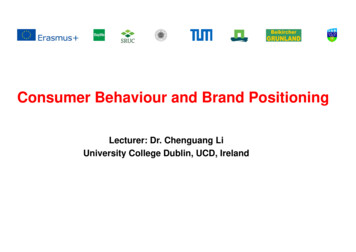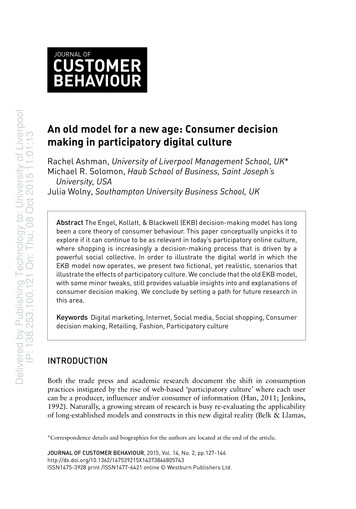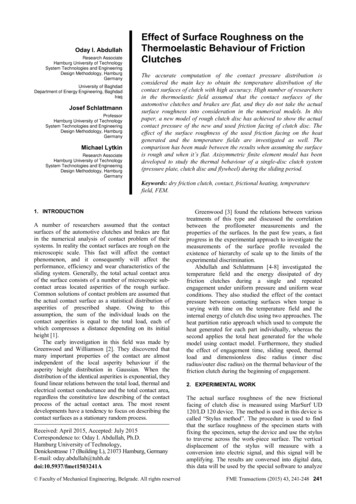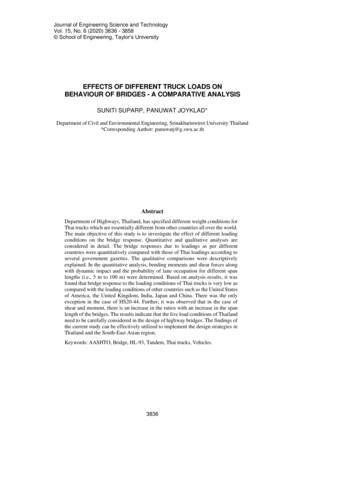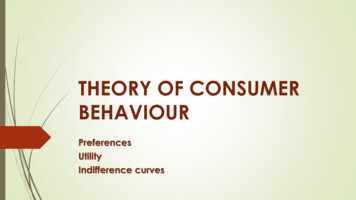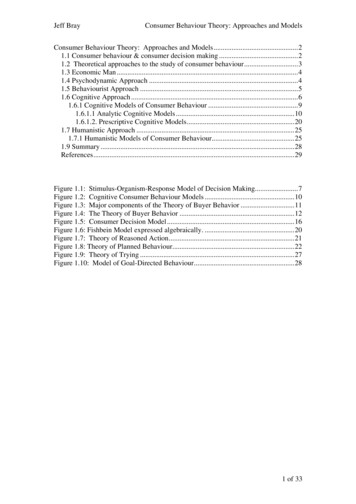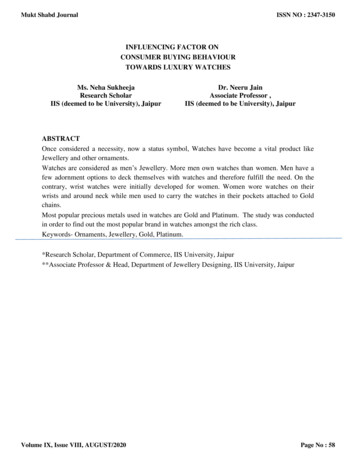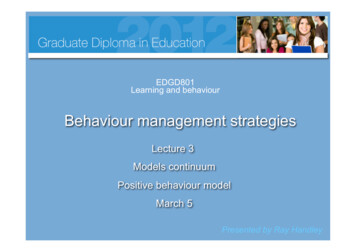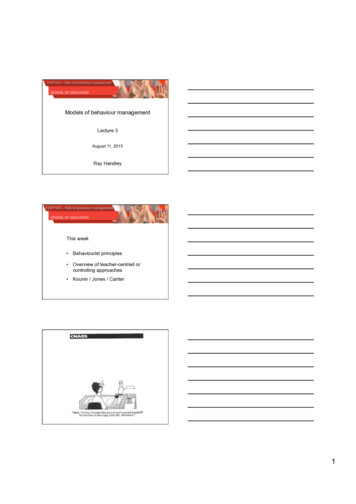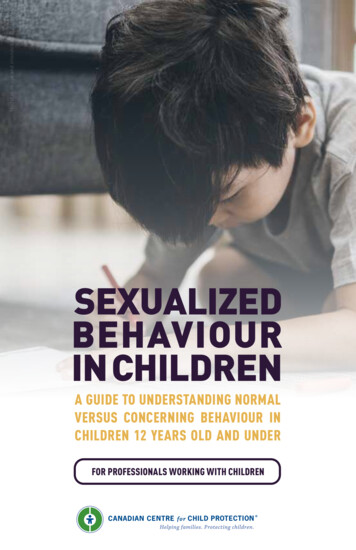
Transcription
Model in image and intended as illustrative.SEXUALIZEDBEHAVIOURIN CHILDRENA GUIDE TO UNDERSTANDING NORMALVERSUS CONCERNING BEHAVIOUR INCHILDREN 12 YEARS OLD AND UNDERFOR PROFESSIONALS WORKING WITH CHILDREN
2019 Canadian Centre for Child Protection Inc. All rights reserved. Stock photos are used under license from a stockphoto provider and depict models. No copying or distribution, including online, without permission.“CANADIAN CENTRE for CHILD PROTECTION” is registered in Canada as a trademark of the Canadian Centre for ChildProtection Inc.January 2020, reprint July 2021ISBN Print: 978-1-989757-10-9ISBN Electronic: 978-1-989757-11-6Acknowledgments: The Canadian Centre for Child Protection worked with Dr. Åsa Kastbom of Linköping Universityin Sweden, as well as consulted with other experts, to create this guide.ii
INTRODUCTIONAdults working with children need to help manage situations and behavioursbetween children on a regular basis. However, when children demonstratesexualized behavior, adults often feel uneasy about how to address it.Understanding what healthy child sexual development and behavior looks likecan help you feel more confident and able to respond effectively.Child sexual behaviour occurs on a continuum and not all sexualized behavioursare problematic. In fact, much of children’s behaviours are considereddevelopmentally appropriate and normal. Yet, on the other end of the spectrum,some sexualized behaviours in children can be a red flag that a child is in distressand needs help.This guide is intended to help adults who work with children understand therange of sexualized behaviours in children. This will help adults support childrenand respond appropriately when these situations occur.A MEASURE FOR WHAT’S NORMALAND WHAT’S NOTNormal: Playful Curiosity and Exploration» Typically, when a sexual behaviour is connected to children’s curiosity andperceived as fun and playful for the children involved, there are no red flagsand no cause for concern (e.g., playfully peeking under the bathroom stalls,or playing, “I’ll show you mine, if you show me yours.”)For many sexualized behaviours in childrenno intervention from adults is required.1
Concerning: Explicit and Preoccupied» A child preoccupied with sexual behaviour, such as persistently wanting totouch their own and/or others genitals and is resistant to redirection» Engaging in behaviour beyond their developmental stage» Behaving in a very sexually explicit or overt way, such as trying to French kissother children or adults» A child using force or intimidation combined with sexual behaviourResearch shows that preschool-aged children who have been sexually abusedshow more sexual behaviour than children who have not experienced abuse. Thisis not to say that all children who act out sexually have experienced abuse orthat all children who experience sexual abuse act out sexually, but uncommon orconcerning behaviour requires careful consideration by adults. Behaviour that isintrusive, hurtful, and/or age inappropriate requires careful consideration, can bean indication of underlying emotional problems, or that the child is living or haslived in an environment where they experienced inconsistent caregiving, violence,abuse, or neglect. The child may have also been exposed to pornography or othersexually explicit materials.FACTORS TO CONSIDER WHEN OBSERVINGSEXUALIZED BEHAVIOUR IN CHILDRENThere are a number of important factors to consider when an adult needs todetermine whether a child’s sexualized behaviour is normal or cause for concern:» Age» Culture*» Developmental level» Religion*» Gender» Awareness» Education» Family attitudes towards sexuality ** Note: These factors — culture, religion, family attitudes towards sexuality —typically influence a child’s comfort level with nudity and/or their knowledgeof sex, however, these factors alone typically do not result in concerningsexualized behaviours.2
Age, cultural norms, and taboos are keyfactors that influence when and wherechildren learn which behaviours areacceptable and which are not.Other Considerations:» Children typically learn to be discrete and selective in displaying certainbehaviours such as touching or showing genitals in public. Displaying thisbehaviour in public after seven years old may be an indication of a stressresponse or trauma.» For many children age seven is the age at which certain behaviours reducein frequency, such as trying to touch a mother’s breasts.» A behaviour that is considered normal by the parents can becomeproblematic, if the frequency is such that it becomes disruptive to the childand/or others. For example, children are very curious about naked bodies,however, if this interest begins to interfere with their play or consumes alltheir interests and time, then it would be considered problematic.There are reasons why children maydemonstrate sexualized behaviours otherthan sexual abuse.Models in image and intended as illustrative.3
RANGE OF SEXUALIZEDBEHAVIOURS IN CHILDRENCOMMON BEHAVIOURSAMONG CHILDREN UP TO SIX OR SEVEN YEARS OLD» Touch and/or explore theirown genitals in both publicand private» Interest in the anatomicaldifferences between malesand females (including nudepictures)» Touch genitals/breasts onparents or familiar adults» Look when people undress orgo to the bathroom4» Ask about the genitals, breasts,intercourse, and babies» Walk around nude» Show genitals to other children» Play doctor; interested ininspecting other people’sbodies» Practice adult behaviour androles by playing parental roles
Model in image and intended as illustrative.COMMON BEHAVIOURSAMONG CHILDREN EIGHT TO 12 YEARS OLD» Ask questions about genitals,breasts, dating, and reproduction» Practice adult behaviour andgender related roles» Ask questions about sex» Draw genitals on human figures» Interest in and curiosity withwatching/peeking at peoplegetting undressed or going tothe bathroom» Draw nude pictures» Interest in inspecting otherpeople’s bodies in real life» Explore differences between malesand females» Compare genitals with otherchildren (sometimes siblings) thatare approximately the same age» Girls pretending to be boys» Show others their genitals,sometimes by playing doctor» Search for nude pictures(what people look like naked) online» Having a boyfriend or girlfriend» Consensual holding hands,hugging, kissing with childrentheir own age» Need for privacy» Touch own genitals (girls not sooften) in public5
UNCOMMON BEHAVIOURSAMONG CHILDREN 12 YEARS OLD AND UNDER» Asking other children toparticipate in sexual activities» Trying to kiss other children oradults with the tongue» Having oral contact with otherchildren’s genitals» Rubbing genitals against otherpeople» Rubbing genitals on objectsin public» Masturbating in public» Imitating intercourse withother children6» Clinging body contact» Playing with feces» Making sexual sounds ortalking in a sexual manner» Inserting objects in rectumor vagina» Playing sexual games withmuch younger or older children» Sexual curiosity with animals
Models in image and intended as illustrative.CONCERNING BEHAVIOURSAMONG CHILDREN 12 YEARS OLD AND UNDER» Compulsive sexual behaviours(excessive masturbation orwatching pornography online)» Forcing, threatening, coercing,or degrading other children in asexual manner or to participate insexual play» Experiencing anger, distress,or anxiety when participating inplaying house, playing doctor, orexploring own or other people’sbodies» Sexually humiliating self or others» Engaging in sexual activity witha sibling» Engaging in sexual activities withmuch younger children» Inflicting pain or genital injuryto self or others» Engaging in sexual behaviourin exchange for something(e.g., affection, items) onlineand/or offline» Engaging in sex and sexualbehaviour with animals» Distributing naked or sexuallyprovocative pictures of self orother children7
RESPONDING TO UNCOMMON ORCONCERNING CHILD SEXUAL BEHAVIOURWhen you discover children are engaging in sexualized behaviour, it is importantnot to overreact or underreact, shame, or embarrass the child. The adult’sreaction can hinder or assist in determining what is going on for the child. In aneffort to obtain more information from the child and better understand what isoccurring, a nonjudgmental and caring response is critical.WHAT TO DO:» Ask questions: Gently ask about the child’s understanding about what theyare doing. Such as, “What are you playing? Oh, where did you get this idea?Have you seen this before? Have you played this before? Who did you play itwith? How did you feel playing this game? I wonder, how do you know aboutthis? I wonder, how do you know how to do this? I wonder, how do you knowhow to find these things?” If the child’s responses lead you to be concerned,document the child’s answers in their own words in case a report needs tobe made.» Stay calm: It is important NOT to come across angry or upset. This willshut down the children from sharing. When an adult is worried or nervous,children often interpret this as anger towards them and they worry that theadult is mad at them.» Don’t punish: Calmly stop the behaviour and redirect the child or childrento something else.» Teach: Teach children about safe bodily boundaries and safety rules fortouching (Visit kidsintheknow.ca for more information).Services Referral» If the behaviour is uncommon or concerning, consult with child welfareabout possible child protection concerns. If child welfare involvement isnecessary, discuss how the caregivers will be informed and any safetyplanning considerations.» If you have no reason to believe there are child protection concerns,nonjudgmentally and supportively discuss the behaviour with the child’scaregivers. Discuss how the child may have learned the behaviour and makea plan for reinforcing safe boundaries and supervision around other children.» It may also be necessary to encourage the family to consult with a childtherapist to determine if more therapeutic supports are needed.8
Early Intervention is KeyMuch of child sexual behaviour is common and doesn’t require any adultattention. However, when behaviour is uncommon or concerning, earlyidentification and intervention is important. Children communicate though theirbehaviour, and it is how they tell us about their experiences and what is goingon for them. Children who are engaging in problematic sexual behaviour rely oninformed and caring adults to intervene and respond protectively.REFERENCES1. Friedrich WN, Grambsch P, Damon L, Hewitt SK, Koverola C, et al. (1992) “Child Sexual BehaviourInventory: Normative and Clinical Comparisons.” Psychological Assessment 4: 303-311.2. Kastbom ÅA, Larsson I , Svedin CG (2012) “Parents Observations and Reports on the SexualBehaviour of 7 to 13 Years Old Children.” Reproductive System and Sexual Disorders 1:108. doi:10.4172/2161038X.10001083. Larsson I, Svedin CG (2001) “Sexual Behaviour in Swedish Preschool Children, as Observed by TheirParents.” Acta Paediatr 90: 436-444.4. Friedrich WN, Fisher JL, Dittner CA, Acton R, Berliner L, et al. (2001) “Child Sexual BehaviorInventory: Normative, Psychiatric and Sexual Abuse Comparisons.” Child Maltreatment 6: 37-49.5. Wiekowski E, Hartsoe P, Mayer A, Shortz J (1998) “Deviant Sexual Behaviour in Children and YoungAdolescents: Frequency and Patterns.” Sexual Abuse: A Journal of Research and Treatment 10:293-303.6. Larsson I, Svedin CG (2002) “Teachers’ and Parents’ Reports on 3- to 6-year-old Children s SexualBehavior – a Comparison.” Child Abuse & Neglect 26: 247-266.7. Kellogg ND (2009) “Clinical Report - The Evaluation of Sexual Behaviours in Children.” Pediatrics 124:992-998.8. Mallants C, Casteels K (2008) “Practical Approach to Childhood Masturbation – a Review.” EuropeanJournal of Pediatrics 167: 1111-1117.9. Reynolds MA, Herbenick DL, Bancroft J (2003) “The Nature of Childhood Sexual Experiences.”In: J Bancroft (ed) Sexual Development in Childhood. Indiana University Press, Bloomington.10. Friedrich WN (2003) “Studies of Sexuality in Nonabused Children.” In: J Bancroft (ed) SexualDevelopment in Childhood. Indiana University Press, Bloomington.11. Kendall-Tackett KA, Williams LM, Finkelhor D (1993) “Impact of Sexual Abuse on Children: a Reviewand Synthesis of Recent Empirical Studies.” Psychological Bulletin 113: 164-180.12. Silovsky JF, Niec L (2002) “Characteristics of Young Children with Sexual Behavior Problems: a PilotStudy.” Child Maltreatment. Volume: 7 issue: 3, page(s): 187-197.9
protectchildren.ca@CdnChildProtectCanadian Centre for Child Protection@cdnchildprotect
» Distributing naked or sexually provocative pictures of self or other children » Engaging in sexual activity with a sibling » Engaging in sexual activities with much younger children » Inflicting pain or genital injury to self or others » Engaging in sexual behaviour
